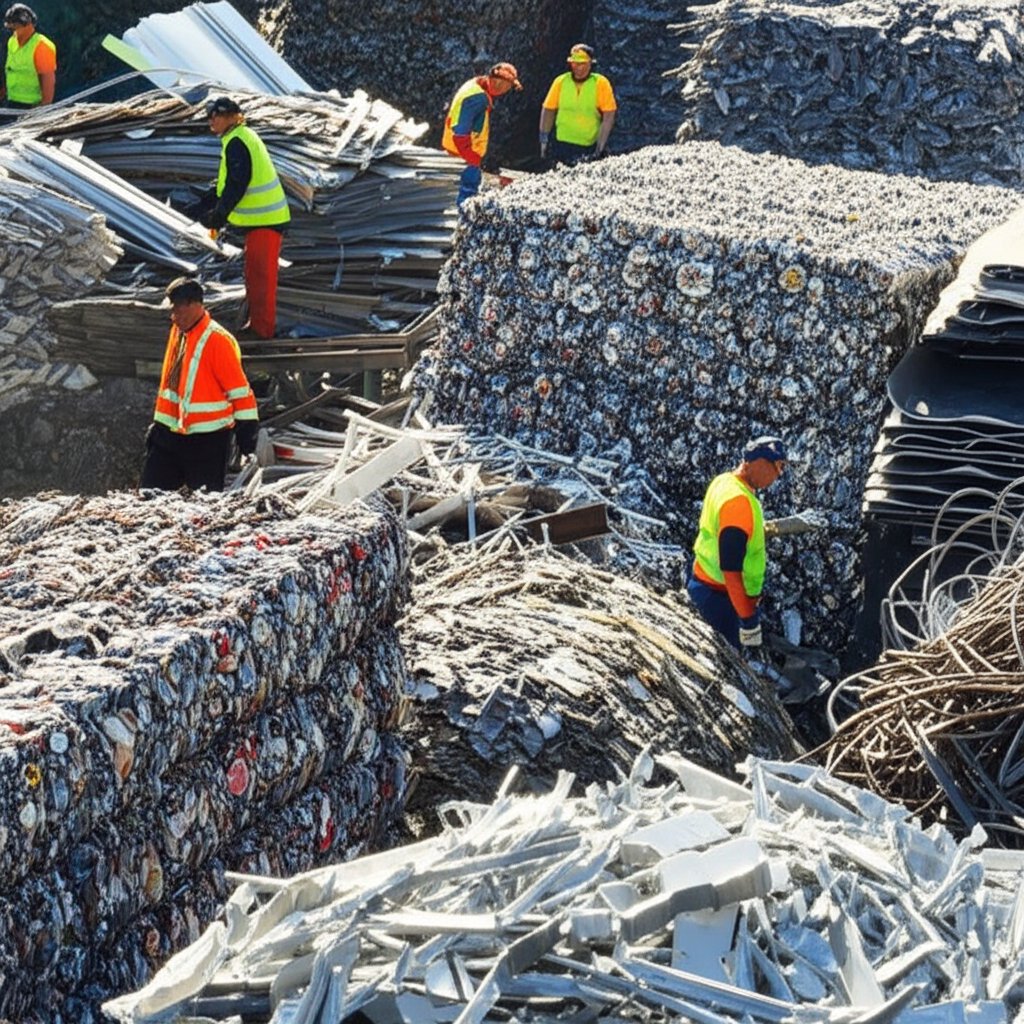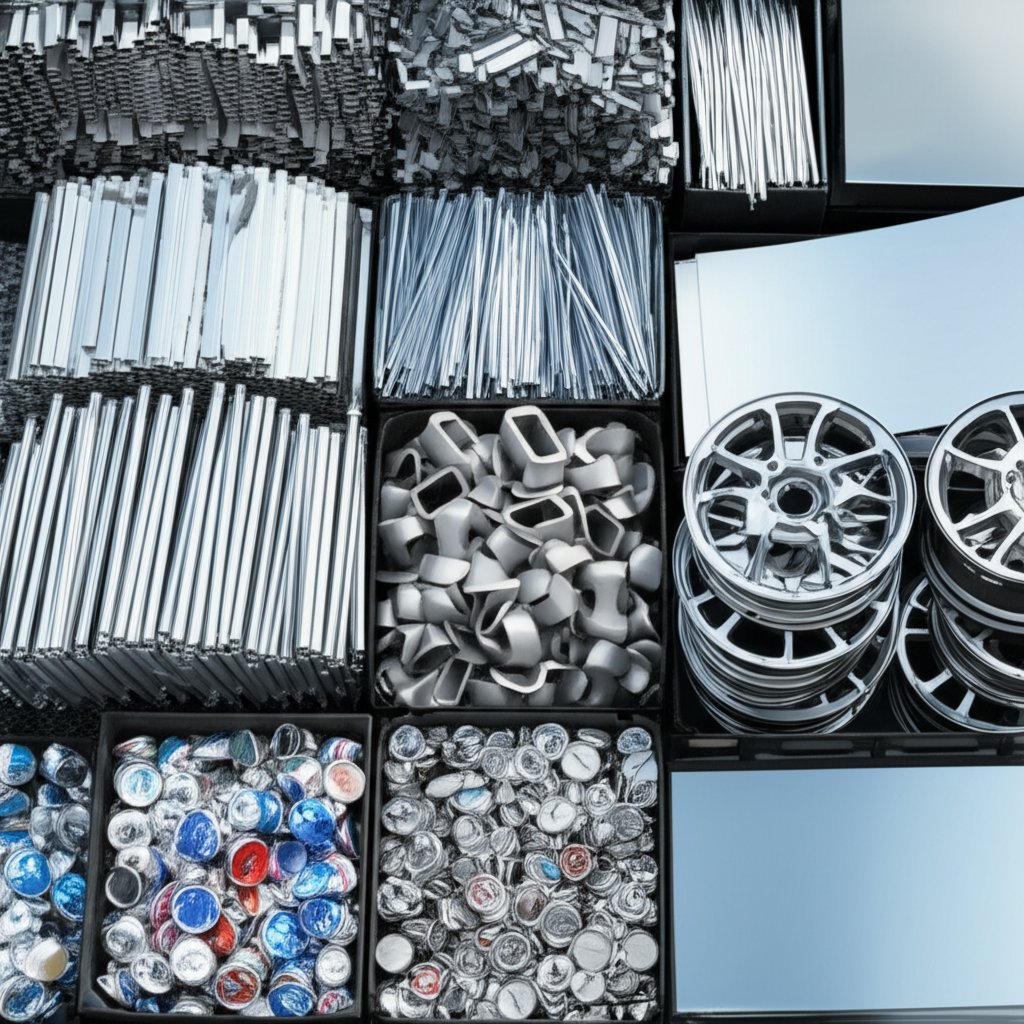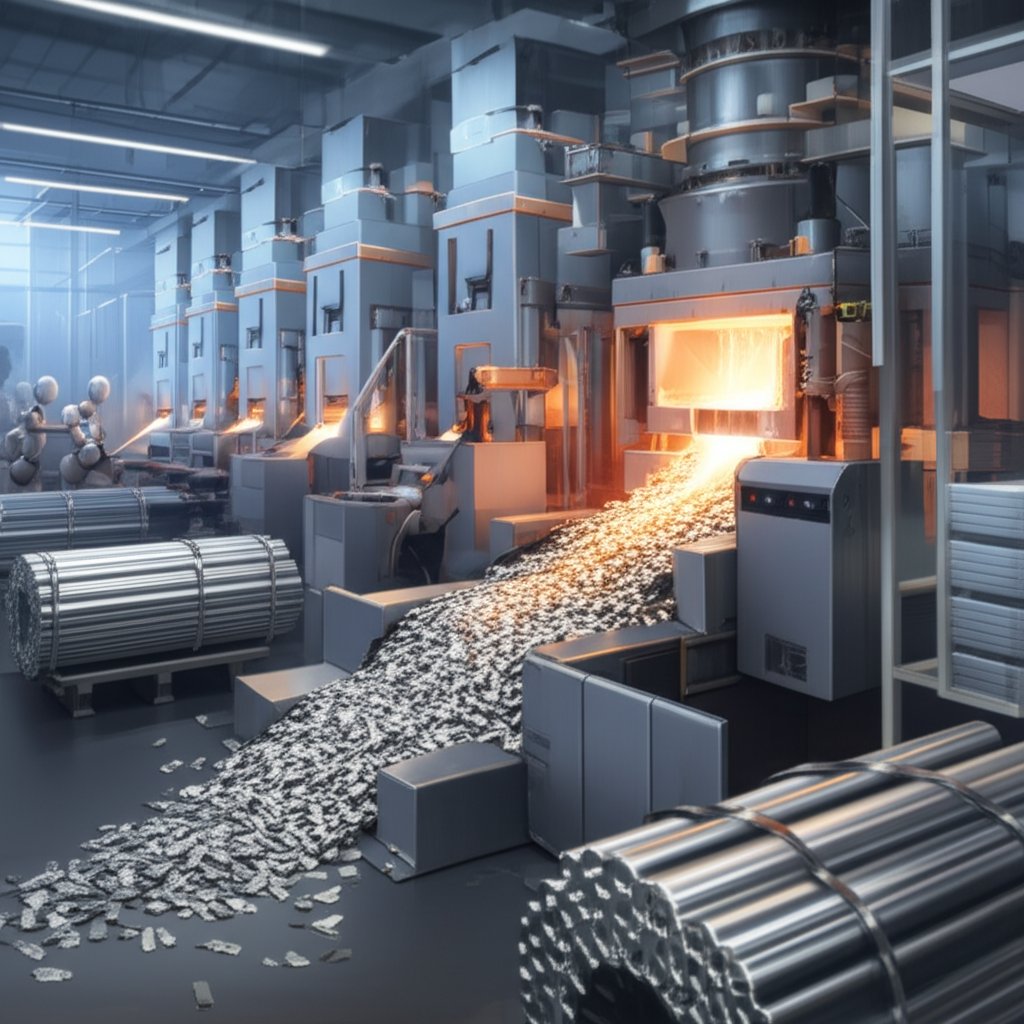
When you see a pile of discarded soda cans or broken window frames, do you ever wonder how much is scrap metal worth? The answer might surprise you—especially when it comes to aluminum. Aluminum is the second most used metal on the planet, woven into everything from cars and airplanes to smartphones and solar panels. But what makes it truly stand out is its role in the circular economy and its remarkable recyclability.
Recycling aluminum saves up to 95% of the energy needed to produce it from raw materials.
Unlike many materials that lose quality when recycled, aluminum retains its full strength and versatility, no matter how many times it’s melted down and reformed. Nearly 75% of all aluminum ever produced is still in use today, circulating through the economy in new forms and products. This infinite recyclability not only reduces landfill waste but also slashes carbon emissions and energy costs—making aluminum scrap a strategic asset in a world moving towards sustainability.
Whether you’re an individual cleaning out your garage or a business managing manufacturing waste, knowing what’s the scrap price of aluminum is crucial for getting the best deal. This guide will break down what affects the price you receive, how to identify different types of aluminum scrap, and practical steps to value scrap aluminum for maximum payout in 2025. Along the way, you’ll learn why aluminum recycling is a win-win for your wallet and the planet, with actionable tips to help you navigate the world of metal recycling value.
Ready to turn yesterday’s waste into tomorrow’s worth? Let’s dive into the essentials of the aluminum scrap market and discover how you can benefit from this powerful resource.

Sounds complex? When you’re trying to figure out why aluminum scrap price changes from week to week, it helps to start with the big picture. The London Metal Exchange (LME) is where the world’s aluminum price is set. This "aluminum spot price per pound" for newly made (virgin) aluminum acts as a global reference, influencing everything from the cost of soda cans to the payout you’ll get at your local scrap yard. If you look at any current scrap metal prices chart, you’ll notice that local and regional scrap prices tend to follow the LME trend, though with a lag and some adjustments for local conditions.
Why does LME matter for scrap? Because scrap aluminum is a substitute for new aluminum in many manufacturing processes. When the LME price rises, scrap becomes more valuable, and when it falls, scrap prices usually follow. But there’s more to the story—let’s break down the other big drivers.
Imagine the global aluminum market as a busy intersection, where many factors come together to influence metal scrap prices:
All these factors weave together to create the dynamic pricing you see on any current scrap metal prices chart. For sellers and buyers alike, tracking these trends is key to understanding why the aluminum scrap price looks the way it does—and when it might move next.
Next, we'll break down the different grades of aluminum scrap and how they affect the value you receive at the yard, giving you a clearer sense of what really drives your payout.

Ever wondered why two pieces of aluminum can fetch wildly different prices at the scrap yard? The answer lies in the grade and type of the scrap you bring in. Knowing how to spot and sort these grades is key to maximizing your payout—especially when you’re eyeing the best extruded aluminum scrap price or want to understand why that old grill could be worth more than a pile of cans.
Let’s break down the most common aluminum scrap grades you’ll encounter, from high-value extrusions and castings to everyday cans and siding. This practical guide will help you identify what you have, where it comes from, and how its value stacks up—because when it comes to aluminum scrap, knowledge really does pay off.
| Grade Name | Common Sources | Key Identifiers | Relative Value |
|---|---|---|---|
| Extruded Aluminum (e.g., 6061, 6063) | Window frames, door frames, curtain wall systems, bicycle frames | Long, hollow, or solid shapes; often clean, sometimes painted; non-magnetic; lightweight | High |
| Cast Aluminum | BBQ grills, lawnmower parts, automotive transmission housings, cookware, light pole bases | Chunky, irregular shapes; looks poured/molded; may have rough surfaces; non-magnetic | High |
| Aluminum Rims | Car and truck wheels (after tire and weights removed) | Thick, round, solid; often stamped with alloy number; must be clean, no rubber/weights | High |
| Aluminum Radiators | Vehicle radiators, HVAC units (after steel/plastic removed) | Fin-tube structure; lightweight; non-magnetic; must be free of contaminants for best price | Medium to High |
| Aluminum Wire | Electrical wiring, power lines, some appliance cords | Silver color; non-magnetic; often flexible; must be stripped of insulation for highest value | Medium to High |
| Sheet Aluminum | Lawn chairs (no webbing), pots and pans, window frames, MC cable jacketing, aluminum sheet metal | Flat or thin pieces; may have small steel/plastic attached; lightweight | Medium |
| Aluminum Cans (UBCs) | Beverage cans (soda, beer, energy drinks) | Thin, crushable, clean; often collected in bulk | Medium |
| Aluminum Siding/Gutters | House siding, gutters, downspouts, shutters | Long, flat, or U-shaped; may have paint or minor plastic attached | Medium |
| Irony Aluminum (Dirty Aluminum) | Anything with steel, rubber, or plastic attached—engine parts, window frames with screws, dirty grill lids | Mixed materials; magnetic parts present; visible contamination | Low |
Imagine you’re clearing out your garage and come across a pile of old beverage cans, some bent window frames, and a few battered lawn chairs. These are classic examples of common aluminum scrap grades—each with its own price point. For instance, aluminum can scrap price tends to be steady, but it’s rarely as high as what you’ll get for extruded or cast aluminum. Meanwhile, items like aluminum sheet metal (think window frames or appliance panels) usually fetch a medium rate, especially if you’ve removed any steel or plastic attachments.
Sorting your scrap by these grades before heading to the yard isn’t just a suggestion—it’s the single biggest factor in getting the best possible rate. Scrap yards pay a premium for clean, well-separated material because it reduces their processing costs and ensures a higher-quality end product (iScrap App). If you’re wondering how to maximize your cast aluminum price per pound, for example, make sure your cast pieces are free from screws, rubber, or grease.
Next, we’ll show you step-by-step how to prepare your aluminum scrap for the yard—because a little effort at home can mean a lot more money in your pocket.
When you’re scrapping aluminum, the first step toward a better payout is sorting your materials by type and grade. Sounds tedious? Actually, it’s one of the most effective ways to boost your return. Scrap yards pay different clean aluminum scrap prices depending on the purity and type of aluminum you bring in. Mixing cans with dirty siding or tossing screws in with extrusions often means you’ll get paid at the lowest rate for the whole batch, rather than the premium for clean, sorted aluminum.
Imagine you’ve done the hard work of sorting—don’t stop there! Cleaning your aluminum is the next critical step. The price of clean aluminum per pound is consistently higher than that of dirty or mixed scrap. Here’s how to make sure your load qualifies for the best rate:
Wondering how much is clean aluminum per pound? The answer depends on market conditions, but you’ll always do better with thoroughly cleaned and sorted material. Some yards may allow up to 10-15% of non-aluminum attachments and still pay a "clean" price, but others require nearly 100% purity—so it’s smart to call ahead and ask about their grading criteria (iScrap App).
Why does a little dirt or a few screws matter so much? Contaminants force scrap yards to spend extra time and money cleaning your material before it can be recycled. This extra labor and processing cost is reflected in the payout you receive. If you’re serious about selling aluminum for the highest return, meticulous preparation is your best friend.
In summary, investing a little extra effort into sorting and cleaning your scrap isn’t just about pride in your work—it’s about maximizing your profit. The next section will show you how scrap yards weigh your material and calculate your payout, so you’ll know exactly what to expect when you arrive.
Ever wondered why the aluminum price per pound you see online doesn’t always match what your local scrap yard offers? When you walk into a recycling facility, you’ll notice that virtually every transaction is based on the price per pound. This approach makes it easy to compare offers, calculate your total payout, and understand the value of your aluminum scrap—no matter the quantity or grade.
But how is this price determined? Scrap yards use certified scales—either truck scales for large loads or platform scales for smaller batches—to weigh your material. The process is transparent: your scrap is weighed, its grade is assessed, and then the yard multiplies the net weight by the current aluminum price per lb for that specific grade. You’ll typically receive a printed ticket showing:
Always ask for the price per pound before you unload your material.
This simple question ensures you know exactly what you’ll be paid—and protects you from surprises at the scale. Because scrap metal price per lbs can change daily, it’s wise to call ahead or check the yard’s website for the most up-to-date rates.
Now, let’s talk numbers. The more you bring, the better your negotiating power. Many scrap yards offer tiered pricing, where larger loads receive a slightly higher scrap aluminum price per pound. For example, if the base rate for clean extruded aluminum is $0.88 per pound, bringing in 500 pounds might net you that full rate, while a smaller batch could be quoted a few cents less per pound due to processing costs (JR's Advanced Recyclers).
Here’s how a typical payout might be calculated:
If you bring 1,000 pounds, and the yard offers a bonus rate of $0.70 per pound for large quantities, your payout jumps to $700.00. That’s why it pays to consolidate your aluminum before selling—and why asking about volume incentives is always smart.
Keep in mind, the metal prices per pound will also vary based on the cleanliness and grade of your scrap. Clean, sorted material always commands the best rate, while mixed or dirty loads may be downgraded to a lower tier.
Understanding how much is aluminum per pound—and how your preparation and quantity affect that number—gives you real leverage at the scrap yard. Next, we’ll explore how regional factors and location can further influence your final payout, so you can make every pound count. For a deeper dive into regional pricing strategies and how to consistently maximize your returns, unlock expert insights in Your Ultimate Guide to Aluminum Pricing.

Ever searched for scrap metal prices near me and been puzzled by how much they differ from city to city? You’re not alone. The price you get for aluminum scrap isn’t set in stone—it’s shaped by a host of local factors that can swing your payout by 20–40% or more, even within the same state. So, what’s behind these regional price swings?
Imagine two sellers: one in Oakland, California, and one in rural Nebraska. The seller in California might see aluminum scrap price California offers that are 30–50% higher than their inland counterpart. That’s not just because of regulations like CRV, but also due to the state’s proximity to Pacific ports and a dense network of recyclers and exporters. Coastal cities often serve as export hubs, so scrap aluminum flows quickly from local yards to overseas buyers, keeping demand (and prices) high.
Inland or rural regions, by contrast, may have fewer outlets for scrap and must factor in the cost of shipping material long distances. As a result, even if the national average is $0.60 per pound for clean aluminum, a seller in a remote area might only be offered $0.35–$0.45 per pound for the same material.
Curious how to get the best price in your area? Start by calling several metal scrappers near me and comparing rates. Don’t forget to ask about volume bonuses or special programs—especially in states like California, where california aluminum can recycling prices can make a big difference for bulk sellers.
Ultimately, where you live shapes your aluminum payout as much as what you’re selling. By understanding these regional trends and shopping around, you can ensure your next trip to the scrap yard delivers the best possible return. Up next, we’ll show you how to track price trends over time and time your sale for even better results.
Ever wondered if you’re selling at the right moment, or if you could get more for your aluminum by waiting a week or a month? That’s where understanding a scrap aluminum prices chart comes in handy. These charts track the ups and downs of aluminum scrap prices over time, showing both short-term fluctuations and long-term trends. But how do you actually read and use them to your advantage?
Imagine you’re looking at a line graph that shows the aluminum scrap price today compared to last month or last year. The vertical axis (Y-axis) displays the price (usually in dollars per pound or per ton), while the horizontal axis (X-axis) shows the timeline—daily, weekly, monthly, or yearly intervals. By spotting peaks and valleys, you can quickly see if the current price of scrap aluminum is unusually high, low, or somewhere in between.
For example, according to Trading Economics, aluminum futures were trading above $2,600 per tonne in August 2025, up nearly 12% from the previous year. Historical charts show that aluminum reached an all-time high of over $4,100 in March 2022, and has since experienced periods of both sharp drops and gradual recoveries. By comparing today’s price to these historical markers, you can judge whether you’re in a seller’s market or if patience might pay off.
Sounds complex? Let’s break it down further. Short-term trends—daily or weekly price swings—are often driven by local supply, sudden changes in demand, or even weather events that disrupt scrap collection. For instance, if you notice a sudden spike on the scrap aluminum prices chart after a major storm, it could signal a temporary shortage, and a good time to sell quickly.
Long-term trends—monthly or yearly changes—are shaped by bigger forces like global economic health, industrial demand, and shifts in recycling policies. For example, in late 2024 and early 2025, prices for aluminum scrap dipped due to cautious buying in the automotive sector and increased imports of cheaper aluminum alloys, as detailed by Procurement Resource. However, as supply tightened and demand from Europe and Asia rebounded, prices began to stabilize and rise again.
So, what can these trends tell you? If the market has been climbing steadily for several months, it might be wise to sell before a potential correction. If prices are near historic lows, waiting for a rebound—unless you need immediate cash—could maximize your return. Always compare the aluminium scrap price today with the previous month or year to spot these patterns.
To make informed decisions, you need access to accurate, up-to-date information. Here are some trusted sources for tracking the current aluminum scrap price and historical trends:
By checking these sources, you’ll stay informed about the price of scrap metal and spot opportunities to sell when the market is most favorable.
In summary, understanding how to read a scrap aluminum prices chart and follow market trends empowers you to make smarter selling decisions. Whether you’re tracking the aluminum scrap price today or planning for the future, a little research goes a long way. Next, we’ll pull together the key strategies for maximizing your aluminum scrap profit—so you can turn market knowledge into real-world gains.

When you’re ready to cash in on your aluminum scrap, it’s easy to wonder: “Am I really getting the most for my effort?” With so many variables—grades, cleanliness, market timing, and location—it can feel overwhelming. But with a few practical strategies, you can consistently boost your aluminum scrap value and ensure your hard work pays off. Here’s a quick checklist to help you maximize every load:
| Strategy | Why It Matters |
|---|---|
| Sort by Grade | Different grades (extrusions, cast, cans, sheet) fetch different prices. Segregate to avoid downgrades and get paid the highest rate for each type. |
| Clean Your Scrap | Remove steel, plastic, rubber, and dirt. Clean aluminum scrap metal always commands a better price per pound. |
| Consolidate Volume | Larger loads often qualify for higher per-pound rates. Consider storing your scrap until you have enough for a bulk payout. |
| Time the Market | Track price trends and sell when rates are high. Use reputable sources to check the current raw aluminum price and historical patterns. |
| Know Local Factors | Compare offers from several local yards. Urban areas or regions near ports may pay more for aluminium scrap for sale. |
Imagine you’ve each step: your aluminum is sorted, cleaned, and you’ve checked the pure aluminum price per pound at multiple yards. You’re not just hoping for a fair deal—you’re setting yourself up for the best payout possible.
What happens to your scrap after you sell it? The journey doesn’t end at the yard. In fact, your aluminum scrap metal is the starting point for high-quality manufacturing. Innovative companies—especially leaders in construction and industry—depend on a steady stream of recycled aluminum to create products like aluminum square tubing, window frames, and components for vehicles or infrastructure.
Take for example a professional manufacturer such as Shengxin Aluminium. With extensive production capabilities and a reputation for quality, companies like Shengxin transform recycled scrap into aluminum profiles, extrusions, and specialty products. Their demand for clean, well-sorted scrap means that what you bring to the yard directly impacts the quality and reliability of finished goods used in everything from skyscrapers to rail transit.
Understanding this end-market explains why yards are so strict about quality—and why your attention to detail matters. High-grade scrap isn’t just worth more to you; it’s vital for manufacturers who rely on consistent, contaminant-free input to maintain product standards and meet industry demands.
In summary, maximizing your aluminum scrap value is about more than just getting paid—it’s about playing a key role in a larger, sustainable ecosystem. Whether you’re an occasional seller or you regularly have aluminium scrap for sale, following these steps ensures your material finds its highest use and delivers the best return. Ready to turn your next load into profit and progress? The path is clear—sort, clean, time your sale, and know that your scrap is powering tomorrow’s innovations.
Aluminum scrap price is shaped by global benchmarks like the London Metal Exchange, local supply and demand, energy costs, regional regulations, and the cleanliness and grade of your scrap. Proximity to ports and local demand from manufacturers also play major roles.
To secure the highest aluminum scrap price, sort your material by grade, clean off any contaminants, and check rates at multiple local yards. Selling in larger volumes and timing your sale when market prices are high can also increase your payout.
Regional differences in aluminum scrap price are due to factors like transportation costs, local demand, state recycling programs (such as California’s CRV), and competition among scrap yards. Urban and coastal areas typically offer higher prices than rural or inland locations.
You can track aluminum scrap prices and trends using resources like Trading Economics, Fastmarkets, and financial news outlets. These sources provide up-to-date charts and historical data to help you time your sale for the best return.
After sale, aluminum scrap is processed and supplied to manufacturers, such as Shengxin Aluminum, who use it to produce high-quality products like profiles, tubing, and components for construction, vehicles, and rail transit, supporting a sustainable supply chain.
 online service
online service 0086 136 3563 2360
0086 136 3563 2360 sales@sxalu.com
sales@sxalu.com +86 136 3563 2360
+86 136 3563 2360